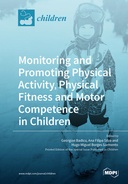Explore

Monitoring and Promoting Physical Activity, Physical Fitness and Motor Competence in Children
0 Ungluers have
Faved this Work
Login to Fave
As we know, a large amount of research confirms that physical activity (PA), physical fitness (PF), and motor competence (MC) are associated with health benefits in individuals of all ages. Achieving a sufficient level of PA and PF will consequently further contribute to better health-related biomarkers. Moreover, holding a good MC allows better participation in PA and exercise in life, promoting greater physical literacy.It is true that the measurement of PA in children and young people is subject to several conditioning factors which threaten validity and reliability. Additionally, it is good to remember that the World Health Organization guidelines on PA and sedentary behaviour for children recommend: (1) 180 min of PA (at any intensity) for two-year old children; (2) 180 min of PA, of which 60 min is moderate-to-vigorous physical activity (MVPA), for 3- to 4-year-old children; and (3) at least 60 min of MVPA for children and adolescents from 5 to 17 years old.Therefore, understanding and developing strategies to promote PA behavior is now more important than in the past, because it is essential to improve fitness levels and MC in early ages. These strategies should cover all generations, children and youth, adults and the elderly, equally, because negative outcomes are visible in individuals of all ages.In this Special Issue, we show contributions that describe and list the link, monitoring and promotion between PA, PF, and MC.
This book is included in DOAB.
Why read this book? Have your say.
You must be logged in to comment.
Rights Information
Are you the author or publisher of this work? If so, you can claim it as yours by registering as an Unglue.it rights holder.Downloads
This work has been downloaded 78 times via unglue.it ebook links.
- 78 - pdf (CC BY) at Unglue.it.
Keywords
- ActiGraph accelerometer
- active free time
- Adolescent
- Adolescents
- ASD
- association analysis
- balance
- Body Image
- body mass index
- body shape questionnaire
- cardiorespiratory fitness
- Cerebral palsy
- Child
- Children
- children and adolescents
- Chinese
- combat sports
- COVID-19
- cross-sectional survey
- early childhood
- Emotional intelligence
- enjoyment
- excess weight
- Exercise
- factors affecting physical fitness
- flat foot
- FMS
- Football
- general intelligence
- Handball
- Health
- Hoff circuit
- Human development
- jump
- junior players
- Lifespan
- Lockdown
- Machine learning
- Mediterranean Diet
- Mental health
- monitoring and promoting
- mood
- motor capacity
- motor competence
- motor development
- motor learning
- motor performance
- Motor Skills
- motor test
- Obesity
- orthoses
- passive free time
- Performance
- PFI
- physical activity
- physical conditioning
- physical education
- physical exercise
- physical fitness
- plantar arch index
- postural control
- programme
- psychological characteristics
- psychomotricity
- Rehabilitation
- Reliability
- sedentary behavior
- sedentary behaviour
- sedentary pattern
- sedentary time
- Self-perception
- socio-ecological mode
- software creation
- space–temporal orientation
- specific intervention
- sport
- sport pedagogy
- Sports Medicine
- sprint
- subtalar flexibility
- the International Fitness Scale (IFIS)
- therapy activation
- urban environment
- verbal encouragement
- Walking
- Well-being
- YBT
- Youth
- Zuchora test
Links
DOI: 10.3390/books978-3-0365-6650-4Editions

